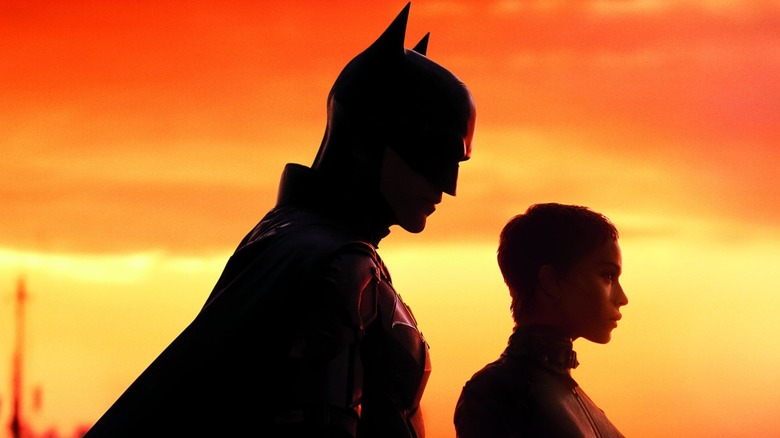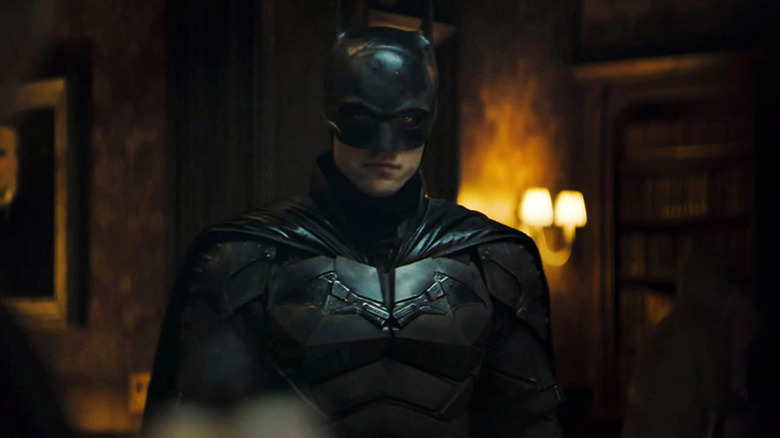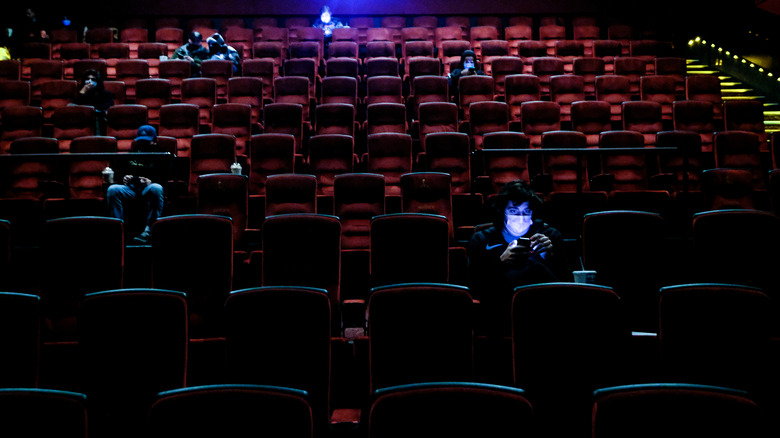Here's Why You'll Pay More To See The Batman In Some Theaters
AMC has big plans to capitalize on the overwhelming anticipation for Robert Pattinson's turn as the Caped Crusader. CEO Adam Aron has announced plans to charge higher prices for tickets to "The Batman," as the theater chain begins experimenting with variable pricing models. This strategy change has been in talks for many years now — and that was back in semi-normal times before COVID-19 arrived to exacerbate the box office woes. Given how common the "movie theaters are dead" refrain has become, it's no surprise that big changes lie in the immediate future. With this announcement, Aron made a point to highlight that variable pricing has been a long time coming. Per Entertainment Weekly, he said:
"This is all quite novel in the United States, but actually, AMC has been doing it for years in our European theaters. Indeed, in Europe, we charge a premium for the best seats in the house, as do just about all other sellers of tickets in other industries — think sports events, concerts, and live theater, for example."
During a recent earnings call, Aron shared that tickets for "The Batman" will be "slightly higher than the prices ... for other movies playing in the same theaters at the same time." The plan mentioned sees AMC charging $1.50 more for an adult ticket, compared to a ticket to another movie at the same time and same venue.
So what's the problem?
Other than the natural sadness of an extra $1.50 departing your wallet, what makes this variable pricing method so controversial? The conversation surrounding this plan has been ongoing for years, often rebutted because of what the varying prices may imply. As financial analyst Eric Handler told The Hollywood Reporter in 2019, "when you charge a lower price, right there you are saying the movie isn't as good as another film. You are saying you have to discount it in order for people to show up."
When you consider other examples of the same product available for varying prices, the number often serves as an indicator of quality. But in this case, it's more a question of popularity. Just like buying a concert ticket for one beloved local band vs. a global popstar, the price doesn't necessarily speak to the quality of the experience or even the music, so much as it does the demand for one over another. Just take a look at the movies being heralded by a certain Hollywood awards ceremony later this month — most didn't make a dent in the box office, especially compared to last year's blockbuster success story, "Spider-Man: No Way Home." In that particular case, charging more for the superhero flick guaranteed to get butts in seats would be incredibly profitable. Per EW, one recent study indicates that 8% of pre-pandemic moviegoers may never return to theaters — if exhibitors don't want that number to come to fruition or worse, rise, then changes must be made.
Variable pricing is the natural next step
These are adapt or die times, teaching distributors and studios alike that if the goal is to turn a profit, then decades-old approaches will need to have new thinking applied. In a matter of months, variable pricing could easily become the new norm. Just think back to all the chaos that erupted when studios first began to float the idea of shortening the theatrical window in the midst of a pandemic. Not to mention the whole day-and-date release debacle. Though we're getting a few more cases of movies debuting in theaters and waiting extensive periods before arriving to streaming, for the most part the theatrical-exclusive window has whittled all the way down to a mere 45 days. Major releases are finding new life on streamers and VOD, barely a month after their theatrical debut. Variable pricing may be yet another necessary evil to transform the industry to suit modern needs and keep theaters thriving.
This recent announcement from AMC is another indicator that theaters are getting that message. Just last week, Cinemark announced that they were testing new ways of handling ticket pricing. CFO Melissa Thomas said the theater chain was "in the midst of a series of tests to better understand how elasticities have evolved during the pandemic to further optimize our base pricing levels going forward." Thomas added that the end result "could mean increases or decreases in pricing, depending upon theater, market, time of day, week, and various other factors."
Years ago, the implementation of "discount Tuesday" price drops helped get more moviegoers in theaters on a day that was generally less popular, which is one minor example of variable pricing. But also, most major theater chains already charge higher prices for evening and weekend showtimes at many locations. Aron dubbed "The Batman" pricing plan a natural extension of this strategy, adding:
"AMC has been a bold thinker in the area of pricing. One who is willing to take risk, and one who is willing to lead, and one who sees considerable upside opportunity for us ahead if we continue to be imaginative."
Given the general hype surrounding the film, speculation that "The Batman" is expected to bring in around 140 million in its first few days of release, and the radical increase in Robert Pattinson gifs across the internet, I'm guessing a minor price increase won't hurt the film's popularity. In the best case scenario, it tests a promising strategy that could benefit theaters in the long run.
"The Batman" hits theaters this Friday, on March 4, 2022.


